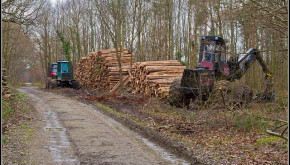
Over the last few months I’ve been getting calls from landowners wondering if they should cut their timber and what they need to know to begin the process. Many have been contacted by a logger and realized there’s an opportunity but aren’t sure how to proceed. Woodland Stewardship Online is a great resource of woodland owners considering timber management. Several specific chapters will be referenced below.
If you’re considering harvest timber, rest assured there are resources to help you understand your options.
1. Woodland Management Plan – Do you have a Forest Stewardship plan or another type of forest management plan? Something that’s been reviewed or created by a natural resource professional that identifies your goals; has map of your property and timber stands and offers general recommendations on how to manage your forest to meet your goals? If not, that’s the first step. Each state does this a little differently but many have Forest Stewardship Plan programs. Information, activities and resources related to Preparing a Woodland Stewardship Plan can be found at this link. (Also noticed there’s a chapter on Conducting a Woodland Inventory if you’d like to learn more about that process.)
2. Finding a Forester - Many woodland owners work with a forester on and off for many years. So finding one that you like and that understands your goals and objectives is important. Take your time and call several foresters until you find one that’s a good fit. You’re likely to need a forester to: write your management plan; inventory your property and timber; offer recommendations on forest regeneration; mark timber to be removed; market the wood for sale; manage the sale and ensure the sale and payments happen as expected. Depending on the service, foresters are often paid either by the hour (for things like writing a management plan) or by a percent of the sale proceeds (for timber harvests). Each state may have slightly different professional organizations for active foresters. In Minnesota the My Minnesota Woods has a wonderful, interactive map the help landowners find Stewardship Plan Preparers. A few common indicators of a committed forester include those that are Society of American Foresters Certified Foresters or members of the Association of Consulting Foresters. Some states have a forester registry or other state supported system for finding foresters, it may be worth looking into these local resources.
3. Selling Timber – Once you have a woodland management plan and have found a forester you’re comfortable with you’re ready to consider a timber sale. Your forester will earn their wages marking timber to cut, marking property and timber sale boundary lines, generating estimates of harvest volume by species and marketing your timber sale to professional loggers that are appropriate for your project (Loggers vary by skill, experience, type of equipment and the markets they commonly work and sell into. Your forester will know the most appropriate loggers for your job – that’s part of what you’re paying them to know!). After the logger has been selected and the sale begins, the forester will again be hard at work monitoring the harvest, checking on the volume of wood removed and making sure the logger is following the sales contract and that you, the landowner, are getting paid appropriately. There are two chapters in Woodland Stewardship Online that are helpful to review: Marking Timber and Harvesting Timber. Remember, it takes time to go from timber sale initiation to harvest and final payment. It’s common for as long as two years to pass before a timber sale is complete. Loggers may only be on site for a few weeks (depending on the size of the sale and the type of equipment the loggers are using). A well done timber sale takes preparation, a contract, marketing and seasonal times to make sure the ground and access roads are not unnecessarily damaged during removal.
By doing a little research and planning ahead you should help to ensure that your timber sale is a good experience for you, good for your land and good for your pocketbook. Remember: if you never thought you’d harvest timber and now find yourself considering it you’re in good company. Very few landowners own their property with the intention of selling wood, but good forest management often includes timber sales, invasive species management, and road and trail maintenance all of which can be done in conjunction with a well-planned and executed timber sale.

